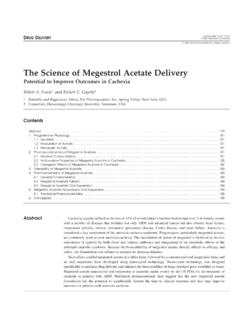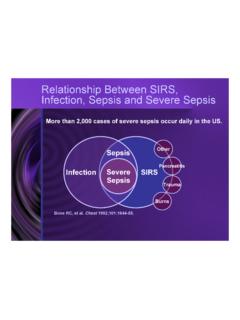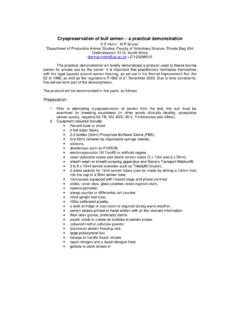Transcription of Hematologic Changes in Sepsis and Their …
1 Hematologic Changes in Sepsis and TheirTherapeutic ImplicationsRichert E. Goyette, ,1 Nigel S. Key, ,2and E. Wesley Ely, , blood and bone marrow constitute the Hematologic organ system. Unlikeother organ systems, Hematologic organs are distributed in space and provide for a varietyof seemingly unrelated functions. The Hematologic system has both cellular and fluid-phaseelements. Cellular elements include erythrocytes, leukocytes, and platelets; fluid phaseelements include coagulation factors, natural antithrombotics, and proteins of the fibri-nolytic system. The most common abnormalities of the Hematologic system in patientswith Sepsis are anemia, leukocytosis, thrombocytopenia, and activation of the hemostaticsystem.
2 Dysfunction of the Hematologic organ system is an early manifestation of severesepsis and is seen in virtually all patients with this disease. In concert with alterations in theendothelium, Hematologic Changes reflect both the body s reaction to an infectious insult aswell as attempts to restore homeostasis. Dysfunction of the Hematologic organ system cancontribute to multiple organ dysfunctions and death. Recognizing these Sepsis -associatedchanges and understanding the underlying pathophysiology are key to improving outcomesin patients with this deadly :Coagulation, erythrocytes, hematology, inflammation, leukocytes,platelets, sepsisObjectives:After reading this article, the reader should be able to: (1) recognize the blood and bone marrow as an organ system; (2)understand the key role played by the endothelium in the septic process; (3) discuss alterations in red blood cells, white blood cells, andplatelets that occur in Sepsis .
3 And (4) describe the therapeutic implications of alterations in formed elements during :The University of Michigan is accredited by the Accreditation Council for Continuing Medical Education to sponsorcontinuing medical education for :The University of Michigan designates this educational activity for a maximum of 1 category 1 credit toward the AMAP hysician s Recognition with acute organ dysfunction (severe sep-sis) is common, frequently fatal, and associated withsignificant use of health care resources. In the UnitedStates alone, there are more than 800,000 cases of severesepsis each mortality in patients with severesepsis ranges from 28 to 50% or greater. Angus et alreport that each organ dysfunction increases the mortal-ity rate of severe Sepsis by 20%.
4 It has been estimatedthat with the increase in the elderly population, use ofmore invasive diagnostic and therapeutic interventions,Management of Shock; Editor in Chief, Joseph P. Lynch, III, ; Guest Editors, Arthur P. Wheeler, , Gordon R. Bernard, Respiratory and Critical Care Medicine, volume 25, number 6, 2004. Address for correspondence and reprint requests: E. Wesley Ely, , , Center for Health Services Research, #6109 MCE, Vanderbilt University Medical Center, Nashville, TN 37232-8300. hematology and oncology, private practice, Knoxville, Tennessee;2 Department of Medicine, Division ofHematology, Oncology, and Transplantation, University of Minnesota Medical School, Minneapolis, Minnesota;3 Department of Medicine,Division of Allergy/Pulmonary/Critical Care Medicine and Center for Health Services Research and the VA Tennessee Valley Geriatric Research,Education, and Clinical Center (GRECC), all at the Vanderbilt University School of Medicine, Nashville, Tennessee.
5 Copyright#2004 byThieme Medical Publishers, Inc., 333 Seventh Avenue, New York, NY 10001, USA. Tel: +1(212) 584-4662. 1069-3424,p;2004,25,06,645,659,ftx,en; increasing numbers of immunocompromised pa-tients, the incidence of severe Sepsis will increase at per year for the next 50 years. The hematologicorgan system is a major element in the response to aseptic insult and plays a pivotal role in the resolutionphase of severe , it is important forcritical care specialists to be aware of the manifestationsand consequences of Hematologic dysfunction in patientswith severe Hematologic ORGANSYSTEM DEFINEDO rgan systems consist of anatomically and/or physiolo-gically related components. Because the activity of mostorgan systems is focused on a single goal ( , gasexchange), the concept is easy to understand.
6 Unlikethe heart or the lungs, however, the Hematologic systemis diffuse, has both cellular and fluid phase elements, andserves a variety of unrelated functions. Consequently, itsrole as an organ system is often elements of the Hematologic system originatein the bone marrow, transit the blood, and then eitherexit the body or are cleared by the reticuloendothelialsystem. Cellular elements include red blood cells, whiteblood cells, and platelets. Fluid-phase components in-clude coagulation factors, natural anticoagulants, andproteins of the fibrinolytic system. Disparate physiolo-gical functions of the Hematologic system include gasexchange, acid base balance, innate and adaptive im-munity, and hemostasis. Hematologic Changes are al-most universal in patients with severe Sepsis .
7 Althoughsepsis-associated Hematologic Changes can be beneficial,dysfunction, evidenced by alterations in the number ofcells, the properties of cells, fluidity of the blood, and/orintegrity of the vasculature, can contribute to bothmorbidity and ENDOTHELIUME ndothelial cell function is tightly integrated with thephysiology of the Hematologic system, and dysfunctionplays a key role in many of the Hematologic manifesta-tions of Sepsis . Therefore, a brief discussion of endothe-lial cell physiology is warranted before Sepsis -relatedchanges in the Hematologic organ system are 1011endothelial cells and a surface areaestimated to exceed 1,000 m2, the endothelium surpassesthe skin as the largest organ in the ,4 The greatmajority of the endothelium is located in the microvas-culature where the endothelial surface area per unit ofblood volume is 2 to 3 thousand times greater than in thelarger blood dysfunction is a keyelement in the pathogenesis of severe Sepsis .
8 This may besecondary to the effects of endotoxin, proinflammatorycytokines, reactive oxygen species, or other substances onendothelial cells. For example, a single injection ofendotoxin in rabbits produces desquamation of 25%of the aortic endothelial surface area within 5 , organisms such asRickettsiaecan directlyinfect endothelial cells and disrupt cellular endothelial injury from a variety of etiologies canproduce microvascular coagulopathy and acute circulating levels of the soluble (s) formsof thrombomodulin (TM), ICAM-1 (intercellular adhe-sion molecule-1), E-selectin, and von Willebrand factor(vWF) are frequently measured markers of endothelialdysfunction and children with septic shock,soluble TM levels are increased and the levels correlatewith survival status and the extent of organ a population of patients with Sepsis , plasma levels ofvWF, ICAM-1, and sE-selectin were significantly in-creased within 8 hours of the development of the acuterespiratory distress syndrome (ARDS).
9 10 Sepsis is asso-ciated with apoptosis of various cell patientswith severe Sepsis , endothelial cell apoptosis may produceabnormalities in trafficking of blood cells into an infectedfocus, vasoregulation, and the antithrombosis thrombo-sis balance that may contribute to the pathogenesis ofseptic manifestations such as multiple organ dysfunction,impaired microvascular blood flow, and inability of thebody to restore OF THE ERYTHRONIN SEPSISThe erythron is the organ responsible for the productionof erythrocytes. It is composed of committed red bloodcell progenitors, developing erythrocytes, reticulocytes,and mature red blood cells. Mature red blood cells areanucleate, hemoglobin (Hb)-containing sacs, with en-zyme systems necessary to maintain the integrity of thesac (red blood cell membrane) and prevent oxidativedamage to the contents (Hb).
10 PhysiologyThe sole function of Hb is oxygen transport; when fullysaturated, each gram of Hb can bind mL of delivery is a critical physiological process that isa function of microcirculatory blood flow, oxygen con-centration in the blood, and oxyhemoglobin the absolute amount of oxygen physically dis-solved in the blood is minimal, the arterial oxygensaturation (SaO2) essentially describes the oxygen thatis bound to Hb. The oxygen affinity of Hb is a measureof the pO2at which Hb is 50% saturated with oxygen(P50). In nonsmokers, the P50is normally mm Hgand varies with the concentration of 2,3-DPG (2,3-diphosphoglycerate), temperature, and Hb concentration is a function of patient age,gender, race, activity level, and altitude above sea IN RESPIRATORY AND CRITICAL CARE MEDICINE/VOLUME 25, NUMBER 6 2004 Following puberty, Hb levels are g/dL higher inmen than in women, a difference that is a function of thephysiological effects of testosterone on the Americans have Hb levels that are g/dLlower than Caucasians.










